Last updated on January 23rd, 2024 at 09:03 am
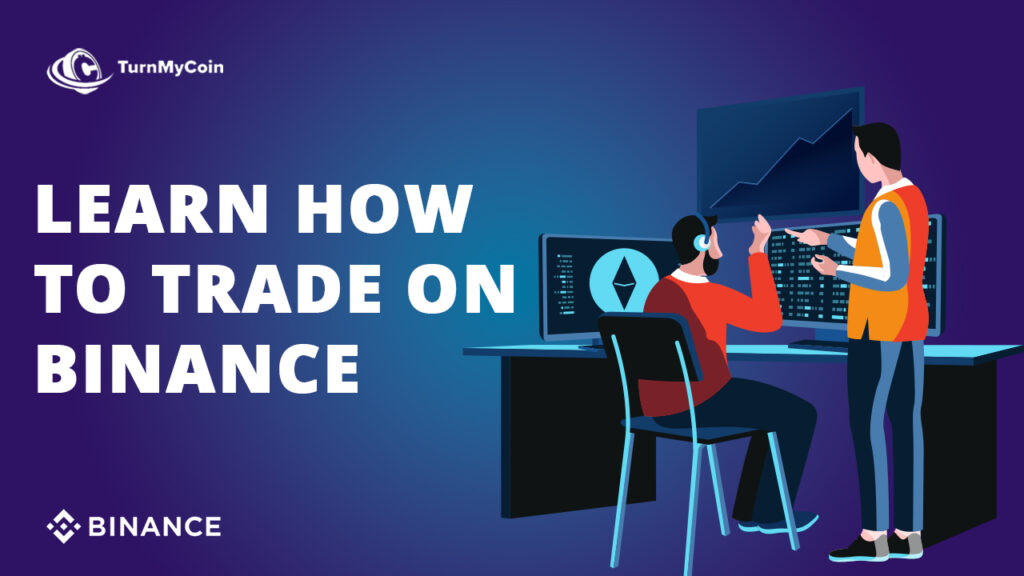
If you’re into cryptocurrency, you’re probably curious about trading you must learn Binance. It’s a top crypto trading platform. It’s user-friendly and makes trading a breeze. But trading cryptos can be confusing. You want to avoid the stress of not knowing how Binance learn works. Cryptos are everywhere now. You can buy stuff with them. It wasn’t like this before. I remember being new to crypto trading.
Picking a reliable exchange was hard. Some were no good, and some were too complicated. Then I found Binance and realized I didn’t know how to use it. That’s why I’m writing this. I’ll explain how to learn and trade Binance, all types of trades, fees, and safety. learn Binance inside out when you’re done reading learning binance. Happy trading!
Table of Contents
What Is Binance and Learn Binance?
Binance, a Chinese cryptocurrency exchange founded by Changpeng Zhao and Yi He in 2017, is a crucial platform for trading. It started in China but left when the government banned crypto trading. Now, it’s in Malta with offices in Taiwan and Japan. Binance Coin (BNB), their own cryptocurrency, offers traders discounts. Most crypto businesses begin with an Initial Coin Offering (ICO) to raise funds. Binance did this too in July 2017 and raised $15 million.
Today, Binance is the biggest exchange on CoinMarketCap, with nearly $18 billion traded daily. Binance used to be crypto-to-crypto, so to trade, you had to own crypto. You’d buy crypto on exchanges like Coinbase, which deal with official currencies like Yen or USD. Now, let’s talk about learn Binance. Trading futures can be profitable, but it’s risky. You speculate on an asset’s future price, but it requires margins. Remember, while wins can be big, losses can be too. So, it’s best for experienced traders.
How Should I Open an Account on Binance?
learn and trade Binance, open an account. Follow these steps: Register, read & agree to Terms of Use and Privacy Policy, verify you’re not a robot, set 2-Factor Authentication for safety.
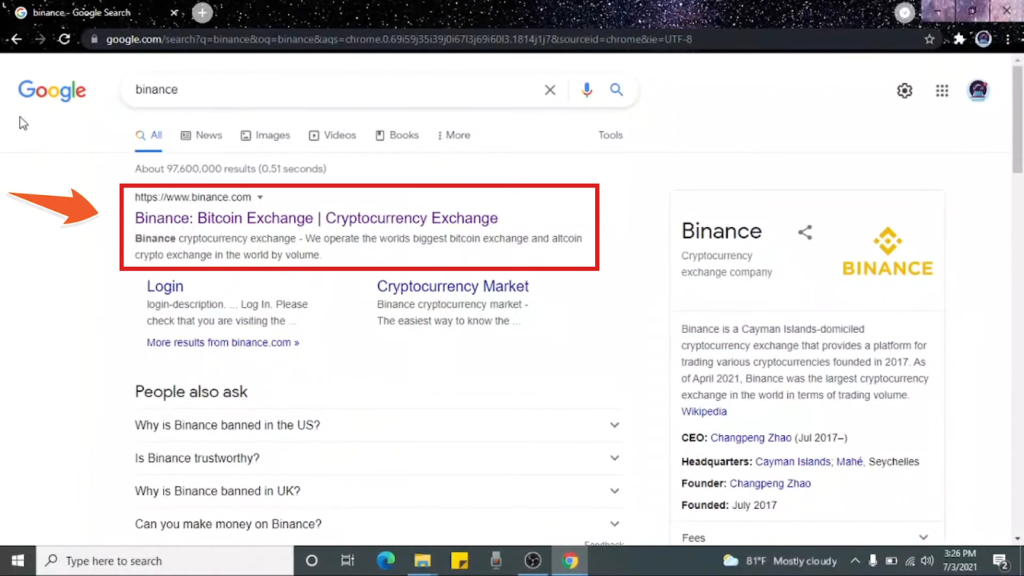
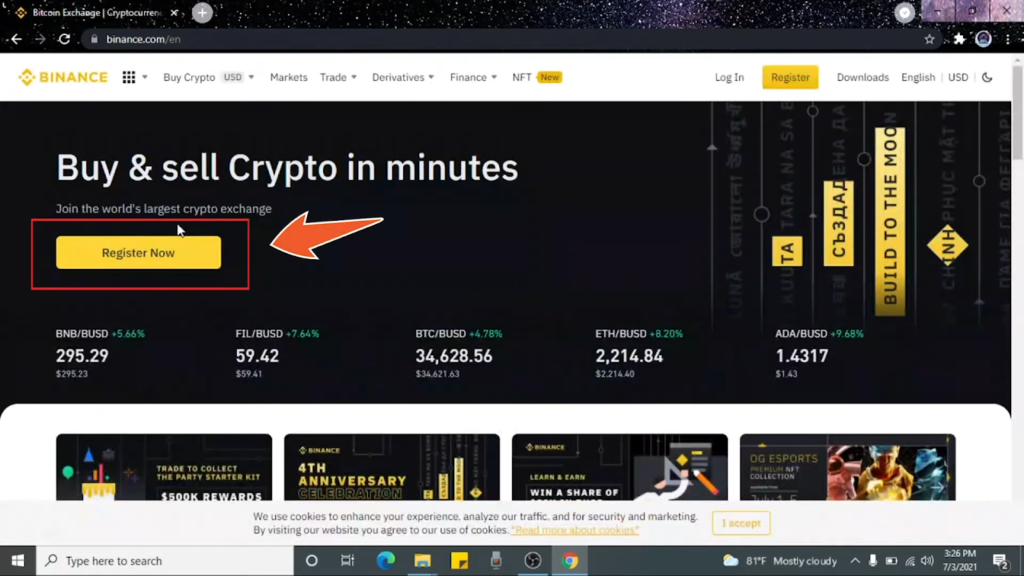
Step 1: Registration
Learn Binance and trade, start by registering. Go to Binance’s sign-up page. Enter your email and craft a strong, unique password. Use a secure email and mix numbers, symbols, upper, and lowercase letters.
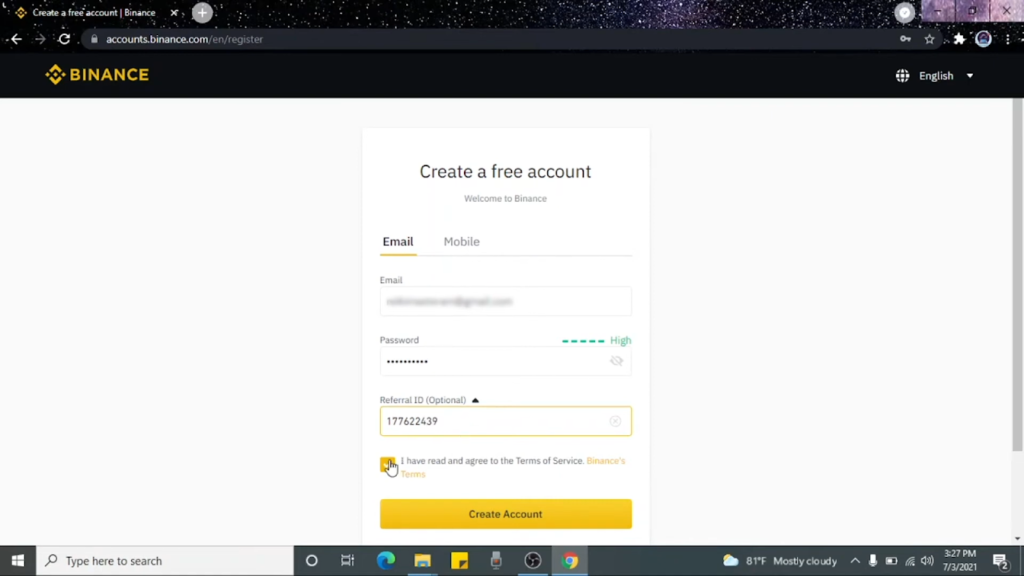
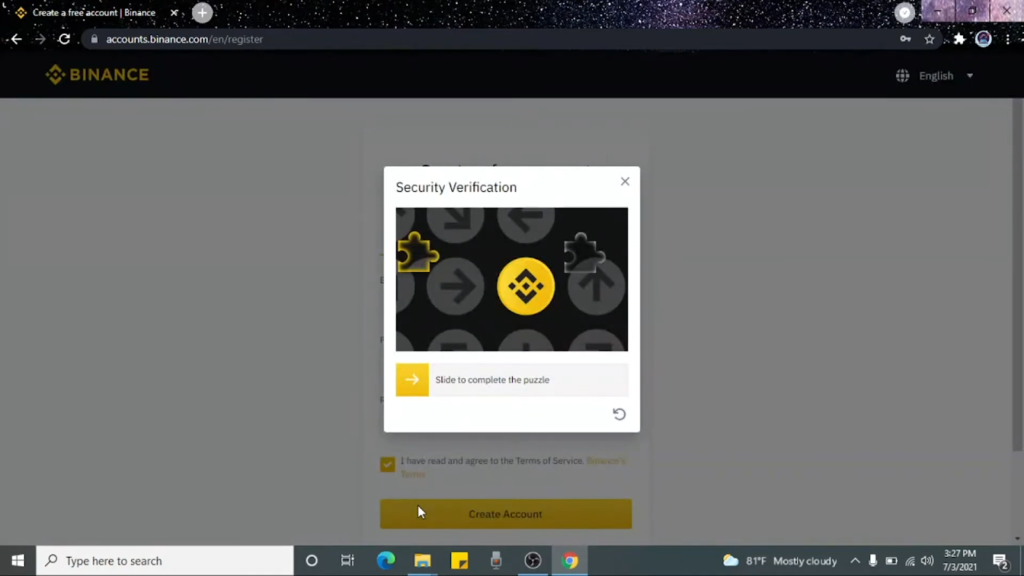
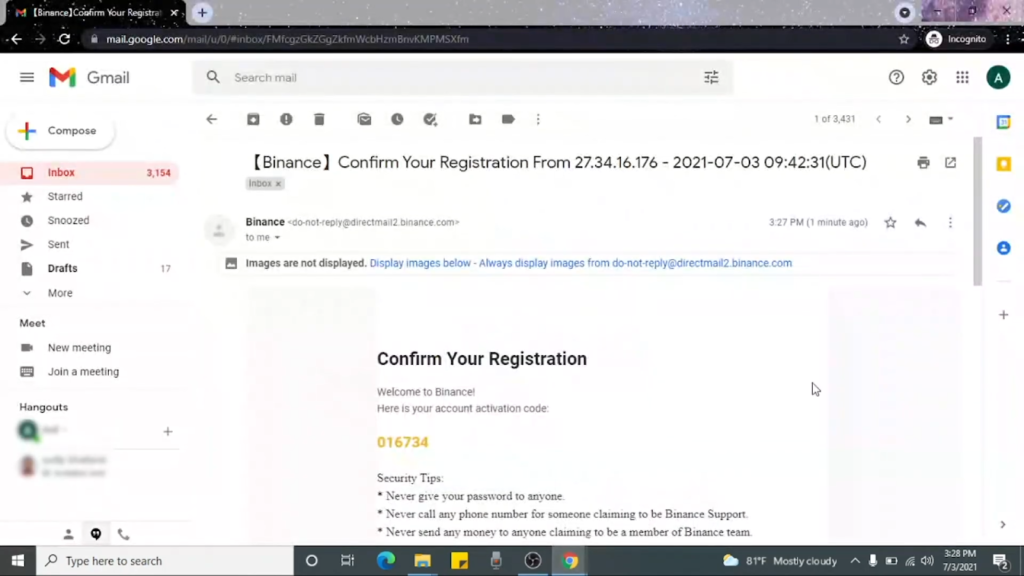
To learn binance and trade on it, read their Terms of Use. Ensure full compliance; don’t skip. It’s vital for your financial safety, not like ignoring Microsoft Word’s terms so binance learn will be helpful with your journey.
Step 2: Verification
Once you read and accept learn and trade binance, you’ll prove you’re not a robot by solving a simple puzzle. This keeps Binance secure. Next, check your inbox for an email from Binance. Click “Verify Email” to finish signing up. Congrats, you’re a Binance user!
Step 3: 2FA
You have a Binance account now. Keep it safe. First login, set up 2-Factor Authentication. It gives extra security.
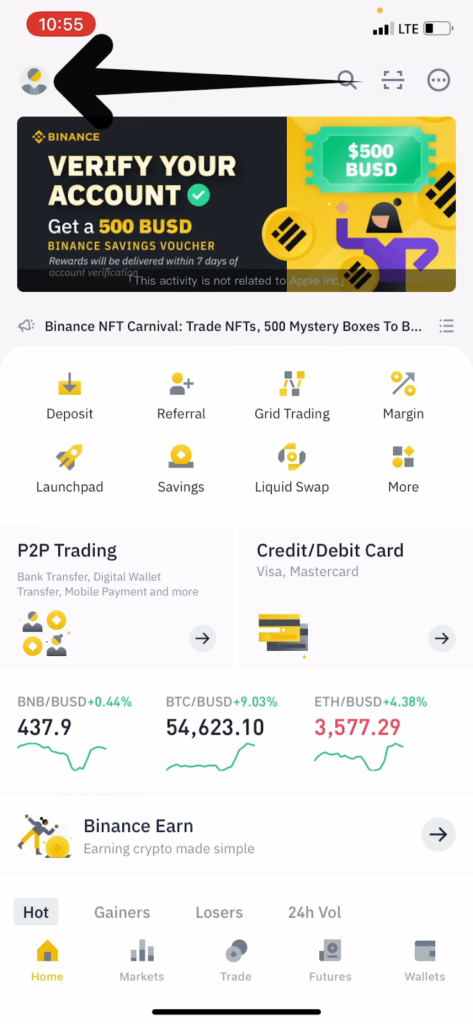
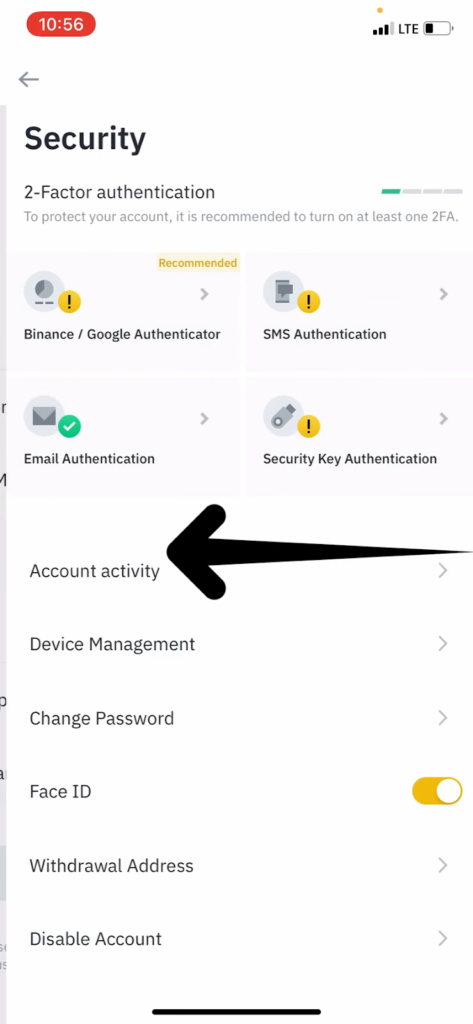
Google Authenticator app sends an SMS for 2FA. To trade, add cryptocurrency.
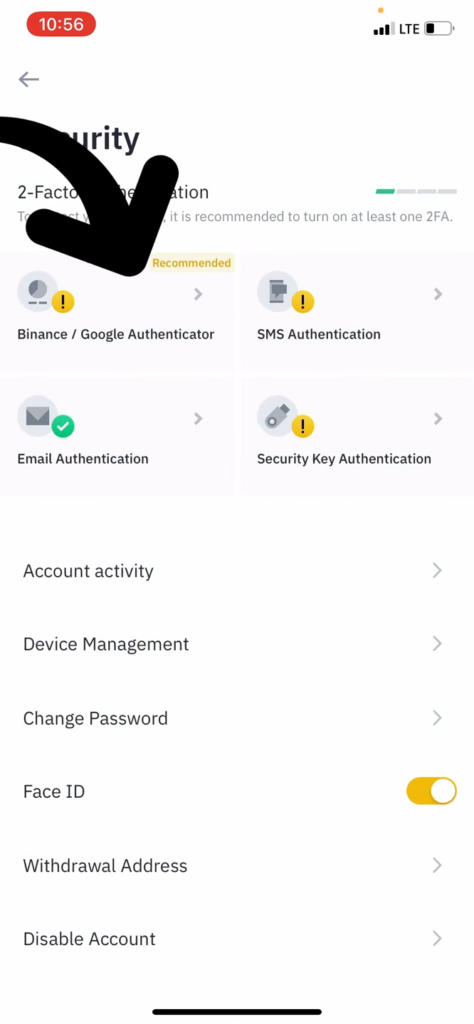
Use a wallet or a fiat-supporting exchange. Congrats on your Binance account!
How Should I Fund My Account?
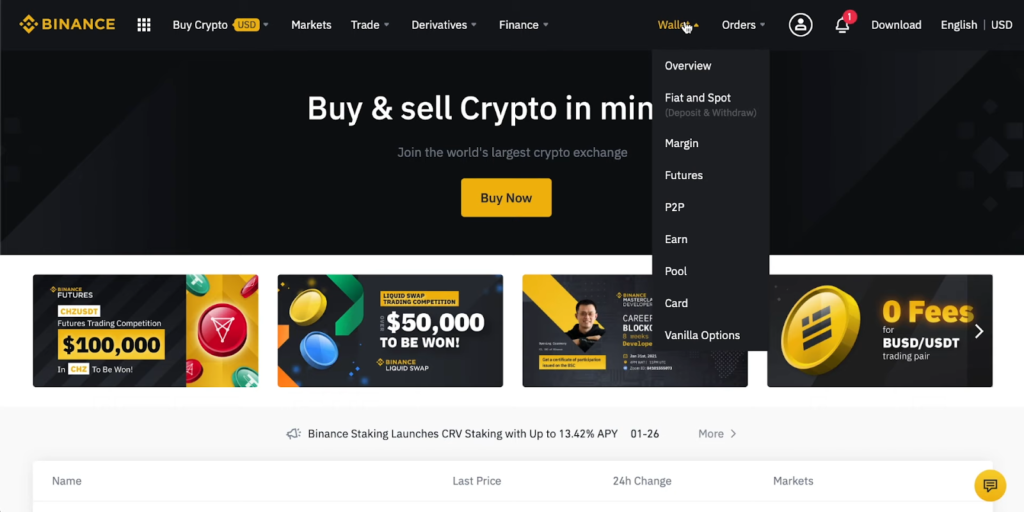
To binance learn and trade , you need cryptocurrency funds. In this part of learning Binance article, I’ll show you how to deposit funds into your Binance account. You can use this strategy on other exchanges too.
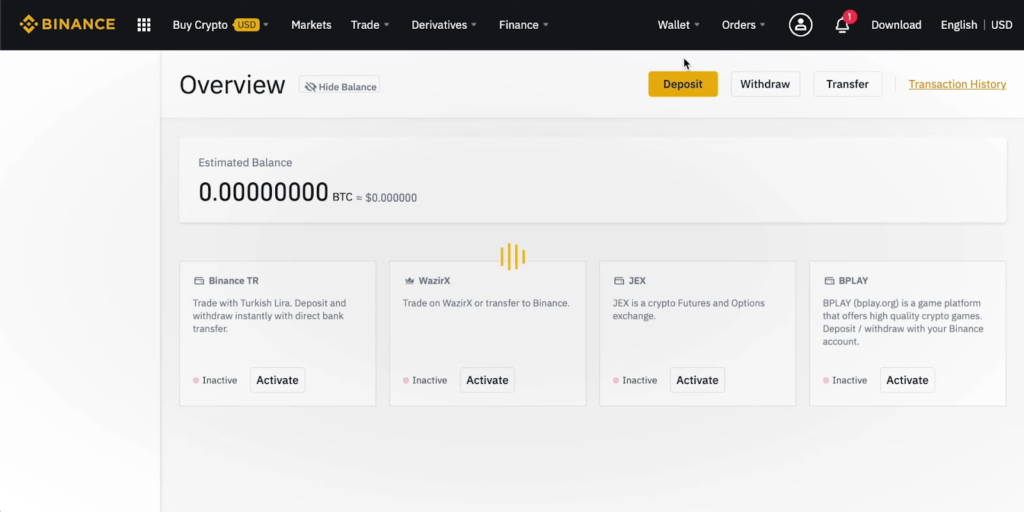
Step 1: Go to Your binance Account.
1. Log in to your Binance account.
2. Go to the Accounts tab.
3. Click the Send button for your chosen cryptocurrency.
4. Enter the recipient address (from Binance).
Step 2: Get Back to Your Binance Account.
Go to your Binance account. Click on Funds. Choose Deposits. Pick the cryptocurrency. Binance gives you an address.
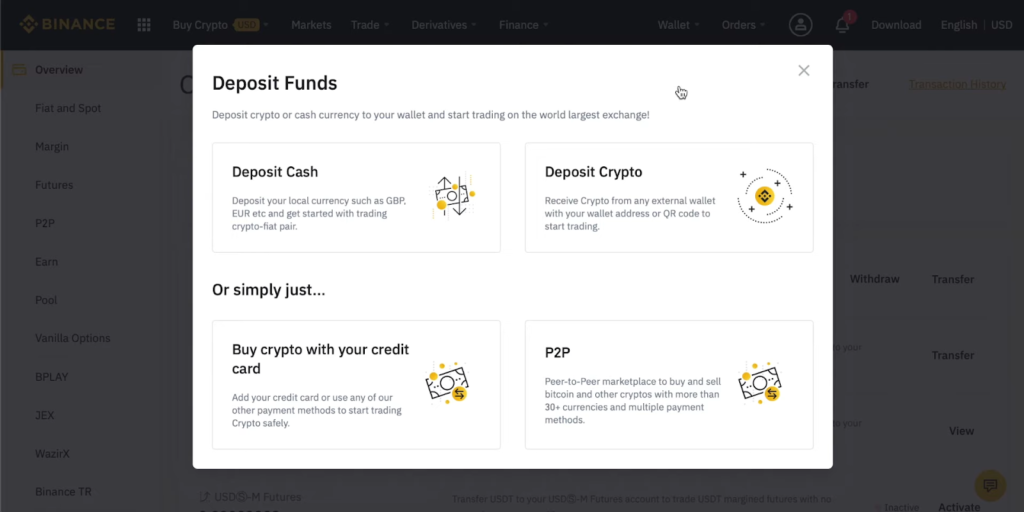
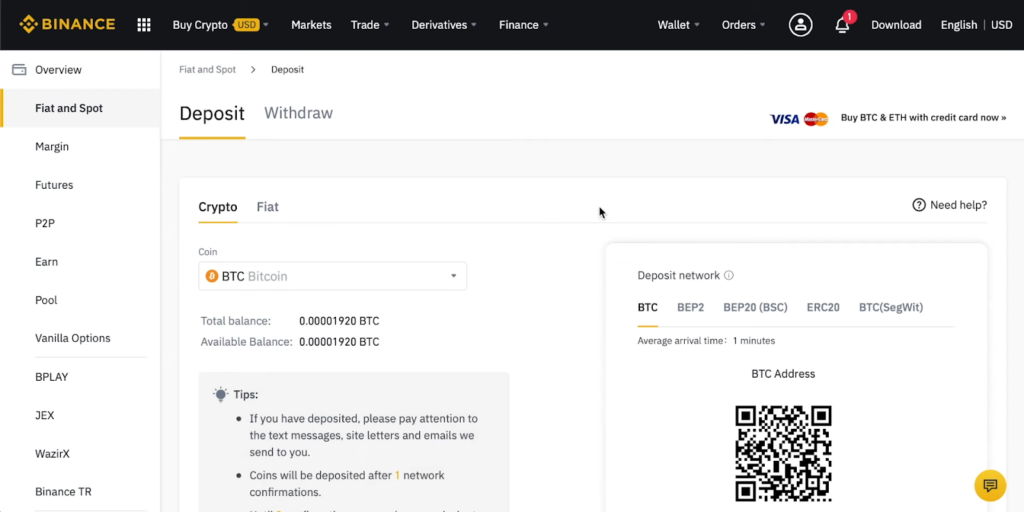
Step 3: Move Your Cryptocurrency.
1. Copy your crypto address.
2. Paste it in your Binance.
3. Choose the amount.
4. Click ‘Send.’
5. Wait for your funds.
6. Check Binance balance.
7. Now, learn Binance trading.
How to Do Futures Trading on Binance?
Leverage helps you make big bets on your investments. For example, if you use 5x leverage, you can invest $20,000 with just $4,000. If things go well, you make 5 times the profit. But if things go south, you could lose a lot too. Keep in mind, the more leverage you use, the bigger the swings in both profit and loss.
Binance futures offers leverage up to 125x or as low as 1x, matching your collateral. You can choose between cross margin and isolated margin modes. In cross margin, your collateral supports all your contracts. In isolated margin, it’s just for specific positions. Now, after learning the basics, let’s binance learn to actually trade futures on Binance.
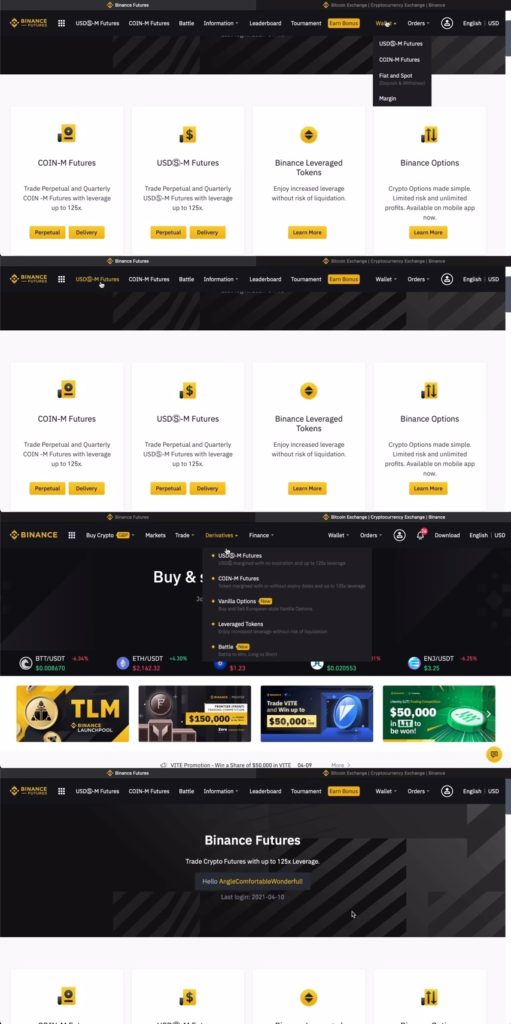
Step 1: Setting up and Understanding the Trading Screen
First, go to your Binance account’s main screen. Find the Derivatives tab at the top; a dropdown menu appears when you hover over it. you can create a Binance account. Remember, Binance is a centralized exchange and requires KYC for sign-up. Depending on your location, joining may vary. Learn crypto binance before signing up.
Next, click on USD-M Futures. The trading screen will pop up. If it’s your first time trading Futures, open a Futures account with Binance on the right. You’ll see prompts, click “Take Quiz” to start trading futures. You shou learn crypto binance to grasp futures basics, especially liquidations and margin. When done, you can start trading.
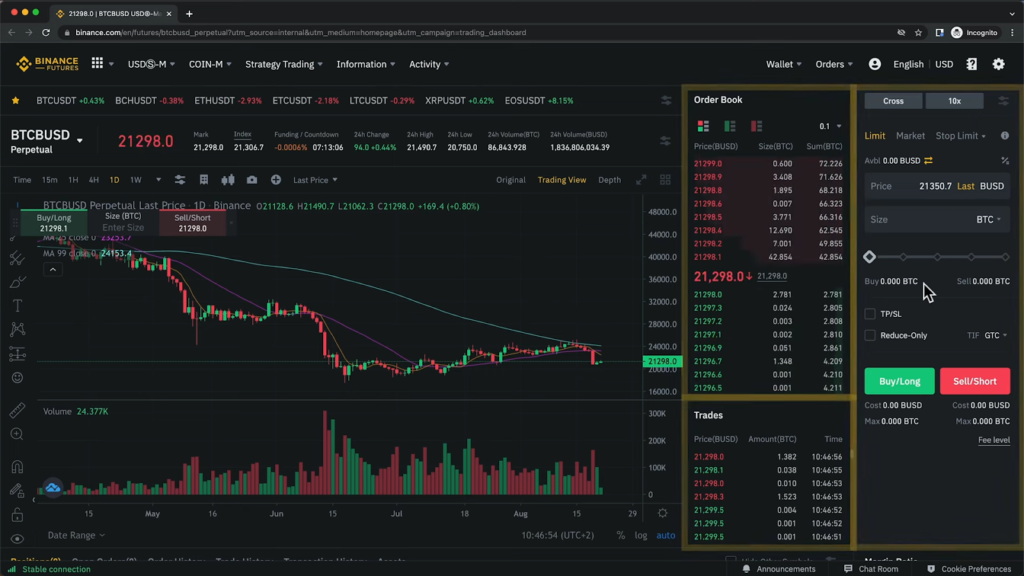
Futures differ from asset trading. In assets, you swap two assets, but in futures, you trade contracts. Futures contracts are visible at the top of your screens.
Just like you access asset pairs for trading, you can search for different futures contracts in the dropdown menu. Since futures are derivatives, you’re not trading the actual asset. A box lets you go long or short on futures. Long for upward price, short for downward.
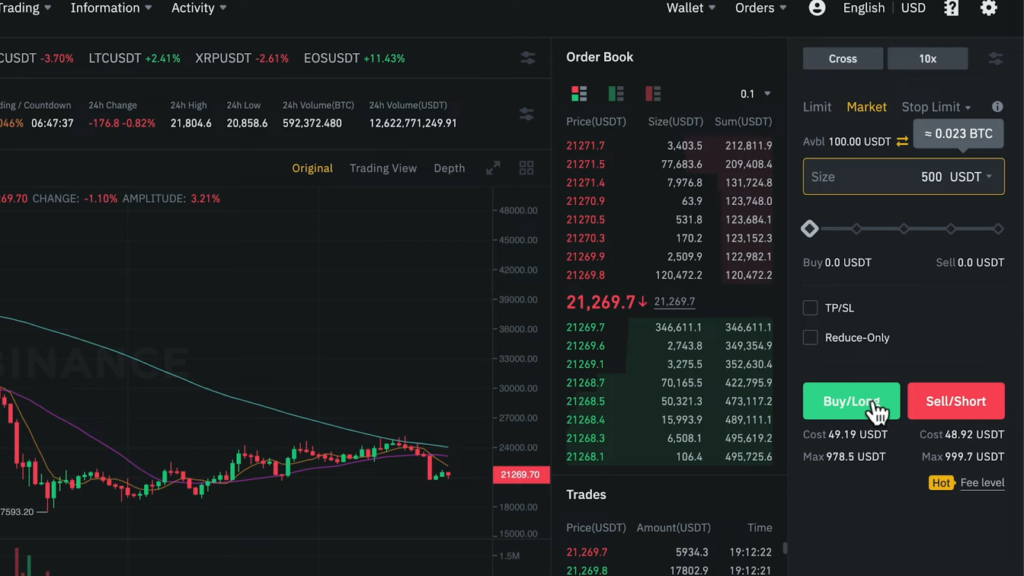
In the dropdown menu, you’ll find various futures contracts, from quarterly to perpetual. Perpetual contracts don’t expire until you decide to close. To open a futures contract, choose USD-M for stablecoin or COIN-M for the base asset, like Bitcoin.
Remember, using volatile crypto assets as collateral, like Bitcoin or Ethereum, might risk losing value. If that happens, your position closes and assets liquidate. It’s best to use a stablecoin to secure your position long-term.
Step 2: Trading Futures on Binance.
To trade futures on Binance, start by moving funds from your spot wallet to your futures wallet. Go to your wallet and pick “Futures.” This takes you to a new screen where you transfer money from your spot account to your futures account. Now, you’re ready to trade on the futures screen.
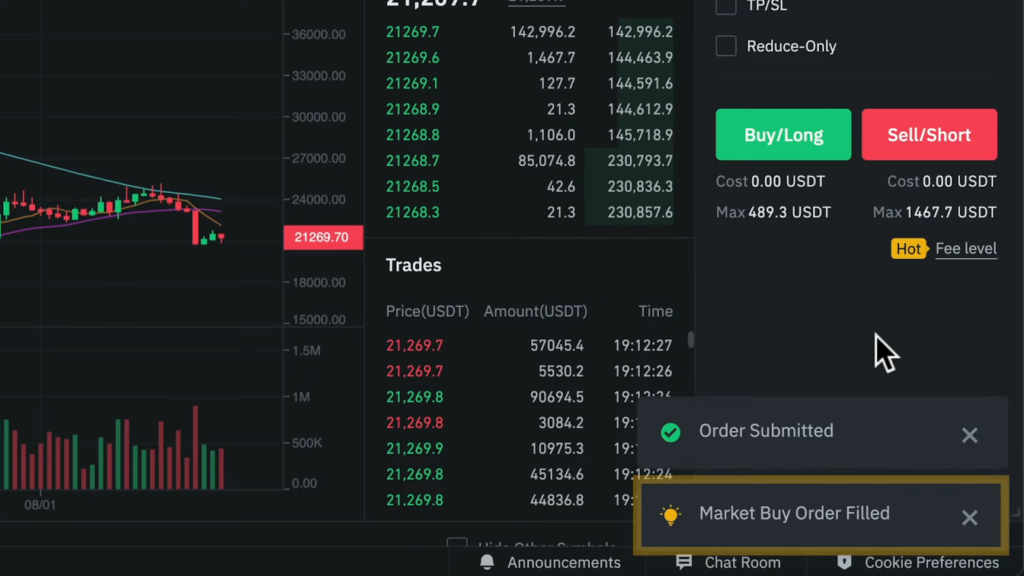
When buying, limit your order with “ReduceOnly” to prevent adding to your position. Use “Stop Market” to open a position at the current market price, ensuring you sell at that set price.
What Is a Trailing Stop Order?
Trailing Stop helps secure profits as prices rise. It locks profit at a set “Callback rate.” But, it doesn’t protect against price drops; your position closes at the market price. These orders work after your position opens. For setting profit and loss limits, use “TP/SL” (Take profit/Stop loss). Imagine having 0.5 ETH at $3000.
If you set a “Take Profit” limit at $3500, your position sells, earning a $500 profit. If prices drop below $3000, like $2500, your position closes with a “Stop Loss” limit at $3500. Futures trading demands market expertise and active participation. To simplify, try Binance’s Grid Trading. Here’s how it works.
Step 3: Understanding Binance Futures Grid Trading
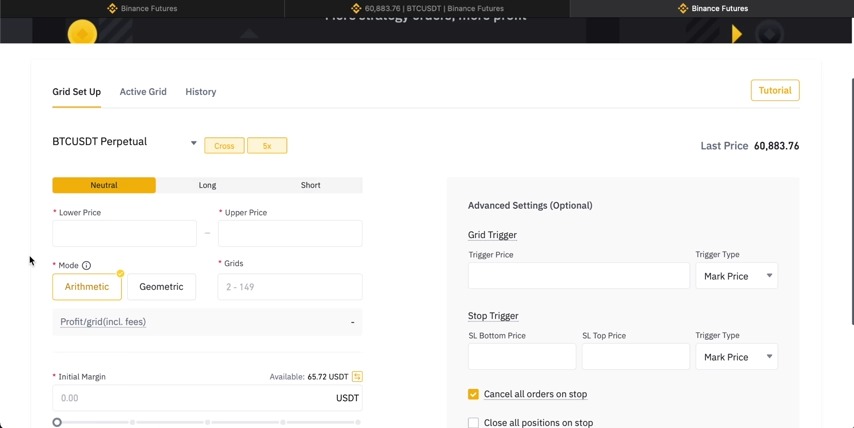
Binance has a handy tool called Grid Trading to make futures trading easier. It automates buying and selling within a specific price range. You can set the range and place buy/sell orders as you like to earn profits. To use it, go to “Strategy Trading” at the top and select “Futures Grid”. Then, go to the new screen. Switch to Manual, set a price range, and, for instance, when it drops below the midpoint, the system starts buying. You can set the number of buy orders with the “Grid.” If the price goes above the midpoint, it sells, ensuring you profit in that price range.
Different Types of Trades
Different trades, contracts, and prices exist for serious traders. Advanced traders learn futures or stick to spot trading. Let’s begin learn crypto binance!
Futures Trading
Futures trading is essential for traders. Learn about futures, how they work, their basics, and pros/cons. Discover trading futures on Binance. Skip if you know the basics.
Fundamentals of Crypto Futures Contracts
Learn key terms. Get closer to trading. Familiarize yourself with derivatives. Take control of this world.
Leverage
Learn about leverage in futures trading. It lets you control a big contract with a small capital. This is your initial margin. 3-12% is usually enough. With leverage, you don’t need lots of money to buy 1 BTC. Just open a long BTC position and start trading futures.
Margin Requirements
An initial margin lets you start trading futures. It’s a part of the position value covered by collateral. Maintenance margin keeps positions open; if it’s reached, positions are liquidated. Regular checks calculate margin use.
Funding Rates
The funding rate ensures index and futures prices meet. Exchanges use it for crypto perpetual contracts. Price gap shapes the rate; investors pay/receive based on open market positions.
What Is a Spot Trade?
Spot trading is when you buy or sell foreign money, stocks, or things right away. This happens on a set spot date. Spot contracts differ from future ones. Interest rates, time value, and time to maturity all matter. In Forex spot trades, it’s called the spot exchange rate. Most trades settle in T + 2. The spot price is the current price. You can buy or sell right away at this price. Traders set the spot price with orders.
It can change in liquid markets because new orders join and old ones get taken. Before you learning Binance to trade spot, understand forward pricing and spot markets first. To spot trade on Binance, first, understand spot trades. Learn key terms for the spot market. If you know these, start trading on Binance.. I’ll guide you step by step!
Forward Pricing
In Forex trades, the final price is calculated using the spot price and the interest cost until settlement.
Spot Markets
Bonds and options trade for spot settlement in 1 day. Two entities hold the contracts. Interest rate swaps settle in 2 days. Trading on Binance is essential. Commodities trade on exchanges. CME Group and Intercontinental Exchange are popular. Intercontinental Exchange owns NYSE.
How to Spot Trade on Binance
You can prepare your spot trades in advance by setting a limit order for a specific price. To spot trade on Binance:
1. Log in or create an account.
2. Pick a cryptocurrency on the homepage.
3. Choose Classic or Advanced.
4. Fill in order details.
5. Click “Buy” to complete your trade.
Binance Trading Fees
Learn trading on Binance. Fees are part of it, but Binance’s got your back! They offer the lowest fees. No deposit fees either! Withdrawal fees vary with your chosen currency, but they’re still less than other exchanges. For example, Ethereum costs 0.01 ETH. Ripple, just 0.25 XRP. Binance limits your trading fees to 0.1% per trade. Even better, they cut it in half if you use BNB. So, your fee is only 0.05% – amazing! Other exchanges like Bittrex and Bitstamp charge 0.25%, five times more than Binance.
Conclusion
This article teaches you learn and trade binance. Your trading abilities matter most. Handling stress is vital. Trading futures is complex and risky. Know derivatives for effective futures trading. Cryptocurrencies are volatile. Leverage magnifies wins and losses. Avoid high leverage when starting. Trade without leverage initially, and consider it later